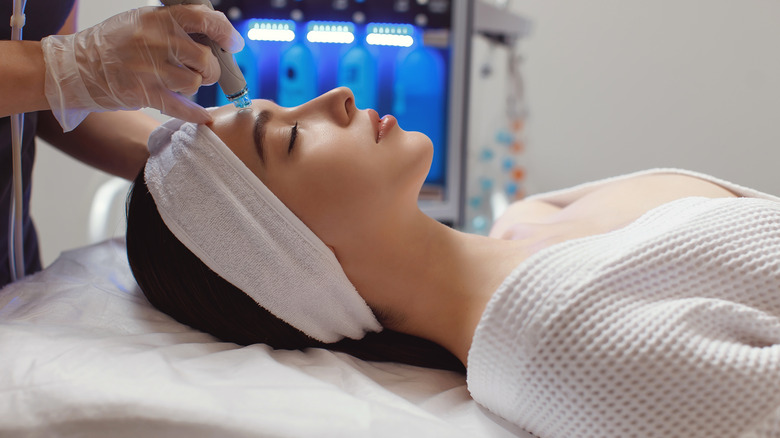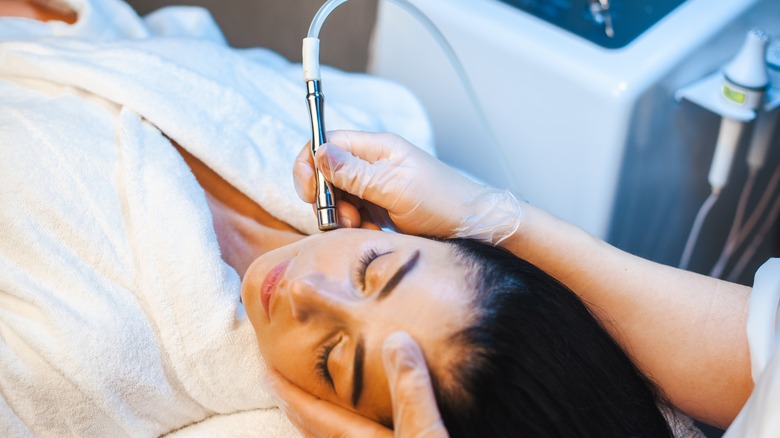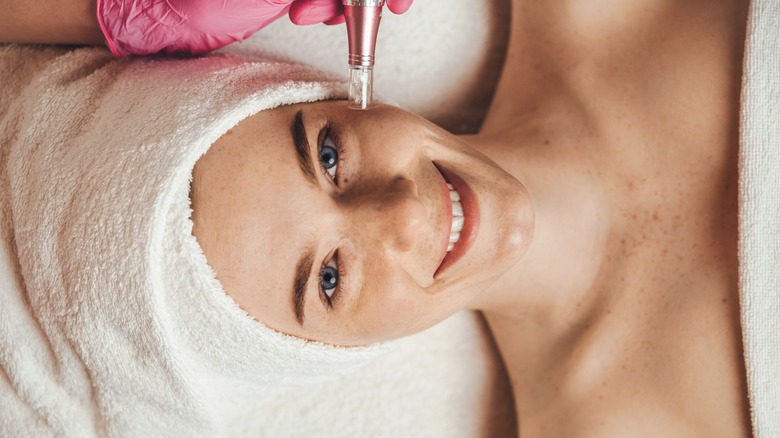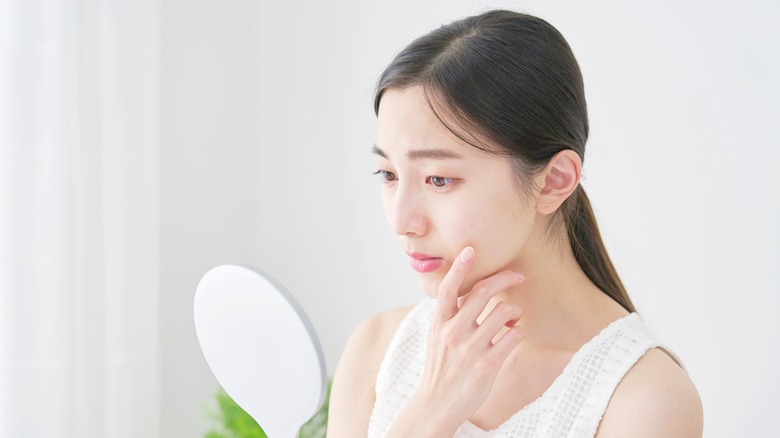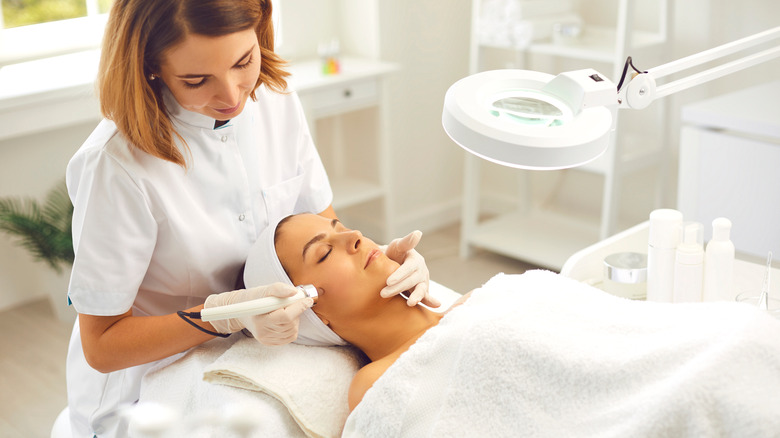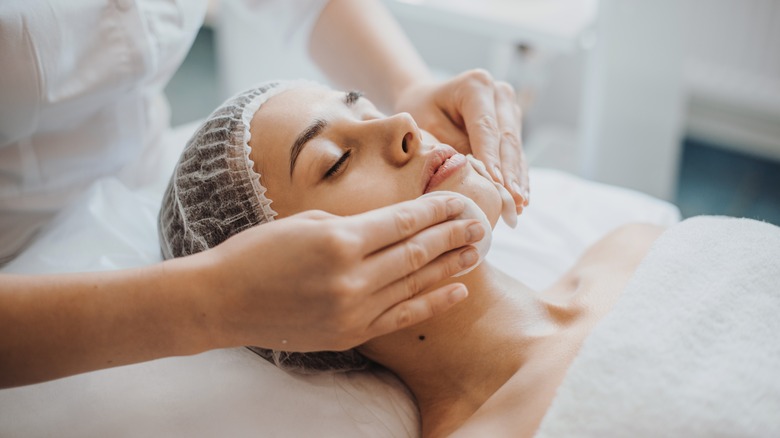Your Guide To Microdermabrasion (& Its Benefits)
If you're a fan of skincare or you're looking into getting a facial, you've likely heard of microdermabrasion. While this procedure has a lengthy, medical-sounding name, it's actually incredibly simple. It's essentially just a more intense form of the typical exfoliation you'll get with chemical products or manual scrubbing at home. Your skin naturally sloughs off layers of dead skin, but by giving it a bit of help, you can more quickly reveal a smoother, more even complexion.
With that being said, however, there's a reason this procedure is performed by a professional. It requires specialized equipment, exfoliates more of the outer layer of skin than at-home methods, and carries a few warnings because of its additional power. This procedure is nowhere near as intense as a chemical peel or a round of Botox, but its still important to do a bit of research to ensure it's the correct choice for you and your skincare concerns.
There are two types of microdermabrasion
The process of microdermabrasion involves sanding away the outer layer of the skin with either a small, rough surface or abrasive crystals, then vacuuming away the dead skin and remaining residue. The first method uses a diamond-tipped handpiece and is a bit gentler, while the second uses aluminum oxide or sodium bicarbonate crystals and is often preferred for less sensitive areas, per Healthline. Your esthetician could use one or both of these methods depending on the sensitivity of your skin and the area in focus.
A third method, called hydradermabrasion, is also common, though it's a newer procedure. In this method, your esthetician will infuse your skin with hydrating serums while simultaneously exfoliating the skin without the use of crystals. Hydradermabrasion is technically a type of microdermabrasion because it uses similar methods and still exfoliates the skin, but it's usually specified as a different procedure or referred to as a hydrafacial.
It's a quick and painless treatment
The idea of essentially sandblasting your face with tiny crystals might seem unpleasant to say the least, but this procedure is actually fairly quick and painless. Because it's done carefully and in a concentrated area, you shouldn't feel more than a bit of texture. According to Skinworks Dermatology, the feeling has been described as a gentle tugging or a facial massage with a bit of added grit. If you're experiencing more pain or discomfort, tell your esthetician right away so you don't cause any further damage to your skin.
This entire process is fairly quick as well. The actual microdermabrasion procedure should only take about 15 to 30 minutes, though if you pair it with a facial, you could spend more time in the chair while they apply additional products to leave your skin feeling silky smooth and supple. It's a quick in-and-out procedure — nothing that requires you to block off a full day.
You should avoid this treatment if your skin is already irritated
While microdermabrasion should be painless, it's still an irritating and abrasive procedure. Because of this, you should avoid booking an appointment if your skin is already facing damage. If you have a sunburn, active breakout, cold sore, rosacea flare-up, or open wound on the area, you should give your skin some time to return to normal before you put it through any more stress.
It's also a good idea to press pause on your typical exfoliating routine while you prepare for your treatment. This includes more obvious things like facial scrubs and exfoliating cloths, but you should wait some time after waxing and dermaplaning or using Retin-A and glycolic acid, too. Essentially, you want your face to be fully healed, free from irritation, and ready to face a more harsh round of exfoliation, even if that means paring down your routine to only the essentials for a few days in the lead-up to your appointment.
It can leave your skin looking fresh and glowy
Microdermabrasion's main draw is obviously exfoliating away dead skin cells to reveal a smooth and supple layer of skin, and, after your first appointment, you'll likely leave the office feeling fresh, glowy, and texture-free. It won't clear away acne or blemishes, but it will help to reduce the appearance of pores and clear away dark spots if you're still recovering from past pimples.
Regular exfoliating treatments can also help to clear out clogged pores to prevent future breakouts, enhance the absorption of your favorite serums and creams, and boost collagen production, leaving you looking more plump. With multiple treatments, you could even see a reduction in visible signs of aging, like fine lines and inelastic skin. Microdermabrasion helps slough off layers of your skin more quickly than your body would naturally, so it helps speed up the time it would take for certain scars and marks to fade.
It's a good option for just about any skin type
Because microdermabrasion is, at its core, just another form of exfoliation, most skin types can benefit from this treatment. Combination and oily skin are the best fit for this type of exfoliation because they can typically withstand a more aggressive form of treatment without feeling sensitive or dry after, and a bit of a deeper scrub can remove any acne-causing oil or dead skin buildup while reducing the appearance of pores.
For dry and flaky skin, microdermabrasion can help sand off the outer layers to reveal softer skin below, though you might want to opt for a diamond-tipped handpiece over the crystals, or stick with a hydradermabrasion treatment to ensure your skin won't be left feeling parched. If you have older skin that's showing signs of aging, this is also a great, non-invasive option to boost your collagen production and decrease fine lines. The only skin type that should avoid this treatment is those with rosacea or sensitive skin (via Skinworks Dermatology). In that case, it's best to stick with a more gentle, chemical exfoliant.
You might need multiple treatments to see more extreme results
One dermabrasion treatment will likely leave you feeling refreshed and ready to face the world, but if you're planning to tackle scarring or more intense damage, you'll probably need multiple appointments to see visible results. You and your esthetician will likely sit down and create a more specific plan to address your skincare concerns, sometimes even incorporating other treatments that can help speed up the process, like a mild enzyme peel or hydrating facial.
For most people, this means anywhere from six to 10 sessions, scheduled with enough time in between to give your skin the chance to heal and return to normal after each treatment. Of course, this varies for everyone. This procedure won't magically cure all of your skincare woes, but, by working with a professional, you can maximize your chances of success and get the most bang for your buck from your appointments.
You should treat your skin gently while you heal
Microdermabrasion is a relatively simple, in-and-out procedure, but you could still face a few side effects while you're recovering. Swelling and irritation are the most common — your skin did just receive a bit of a beating, after all — but this should go away in less than a day. This swelling and redness should only feel like a mild sunburn at the worst. If you're in real pain or experiencing the symptoms of an allergic reaction, you should see a doctor right away.
Immediately after heading home, if you want to minimize your discomfort, you can apply a cold compress or take a few ibuprofen to take the edge off of the swelling and redness, but this should go away in the next few hours. You might not be feeling any serious side effects after your appointment, but it's still important to treat your skin with a softer hand for a little while. Wearing makeup and going to the gym is fine because you won't be left with any open wounds or needle pricks, but medicated cleansers and retinoids could burn and dry out your skin while it's still a bit raw from the intense exfoliation.
It's a fairly inexpensive procedure
In the grand scheme of cosmetic procedures, microdermabrasion is very basic, and the cost reflects that. This treatment is typically offered at spas as an alternative to a typical facial, so the cost is about the same — much lower than some other treatments that guarantee similar results but are more invasive. This, of course, depends on your area and the general pricing of their other procedures, but it's typically in the realm of $100 to $250 per treatment (via MedicineNet). Keep in mind, however, that costs can add up quickly if you opt for a series to treat deeper skincare concerns.
A higher price doesn't necessarily mean you'll be getting better results, so it's a good idea to shop around your area until you find an esthetician that's qualified and makes you feel comfortable. The procedure doesn't differ much based on where you get it done because the equipment, for the most part, is the same, so your decision should be based more on who's doing the treatment and their skill level so you can guarantee results and an experience you're happy with.
